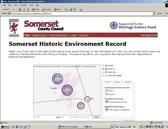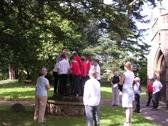Somerset County Council HER
Region: South West
Owner Type: MANY
Funding Body: HLF and Somerset County Council
Year of Intervention: 2003 - 2004
Summary: A project to make available online Somerset County Council's 'Historic Environment Record' A comprehensive list of 21,000 records concerning all known archaeological sites in the county and also including Scheduled Monuments, Listed Buildings, Registered Battlefields and Registered Parks and Gardens.
Somerset, in the southwest of England, has a population of 500,500 residents. It covers a geographical area of 3452 square kilometers and has topography of broad coastal plains interrupted by several ranges of low hills. There is an abundance of archaeological evidence to be found in the county, ranging in date from the Paleolithic through to the Second World War and modern times.
The Somerset Historic Environment Record, a public record, existed in the form of several large filing cupboards of numerically ordered files, a computer database and a Geographical Information System computerized map. Individual appointments and correspondence by letter, phone or email achieved access to this information for members of the public. This created an access problem for people unable to get to Taunton easily. It also meant that relatively straightforward queries often took a long period of time to resolve.
Although a vital resource and useful starting point for research the very existence of the HER and the various ways in which it could be used were not well known amongst the general public.
There has been a very positive response to the website both from members of the public, heritage professionals and HER staff. The profile of the HER and the group as a whole has become much more prominent with many mentions on local websites, local publications and in all forms of the media.
The main advantage for the users of the HER is that their queries can be answered much more speedily through the direct access to the information. The advantage for the HER staff has been the time gained that would normally have been involved with postal/telephone/email to-and-froing trying to understand exactly what an enquirer actually wants and seeking out and sending off that information. The enquirer now has direct control over the information seeking process. Although registration is not obligatory in order to use the site there are now 705 registered users of the website, many of whom are regular visitors. In June 2004 there were 1159 visits to the website, 349 of which visited more than once in that month alone.
Keywords: Education and Outreach; Social Inclusion and Access; Research and Archives


